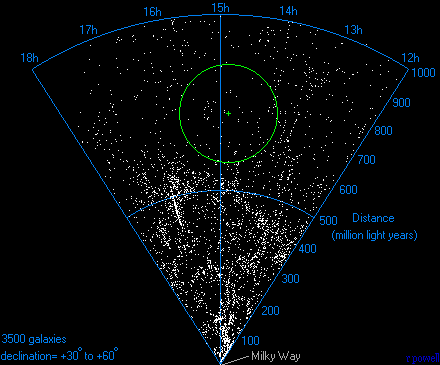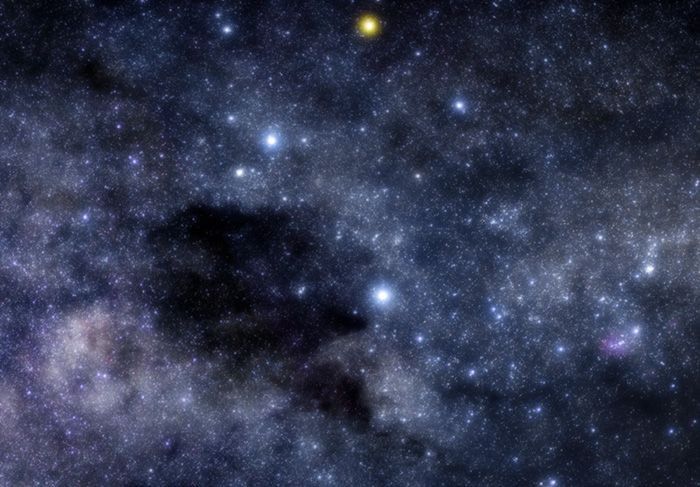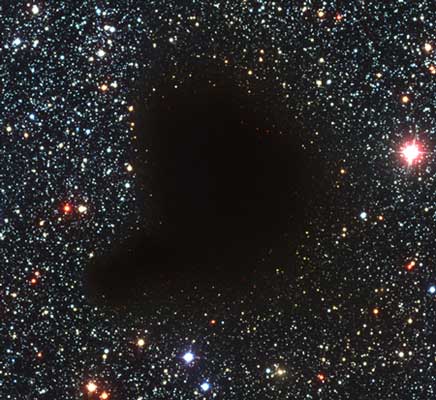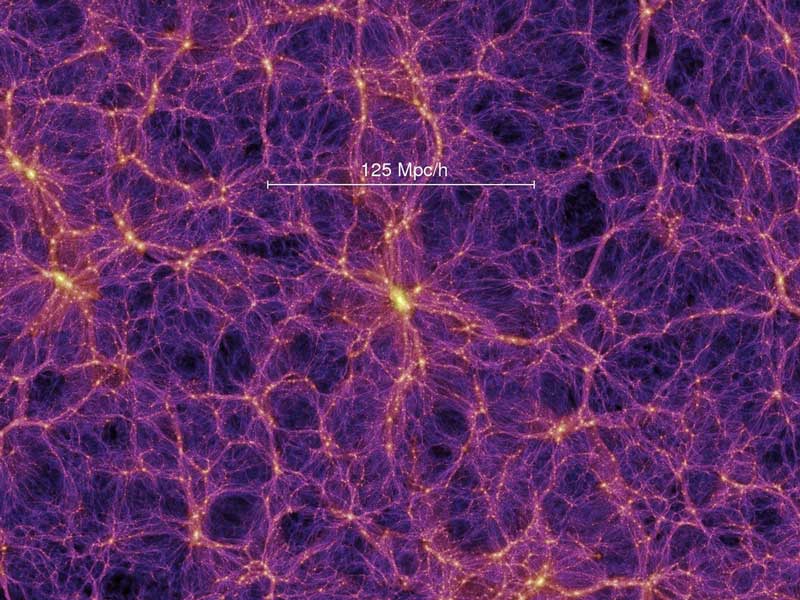It looks like you're using an Ad Blocker.
Please white-list or disable AboveTopSecret.com in your ad-blocking tool.
Thank you.
Some features of ATS will be disabled while you continue to use an ad-blocker.
share:
Reading through a few interesting threads here:
just found galaxy casts doubt on the age of the universe
Big Bang - Where's the hole?
It raised some interesting thoughts. How old is the universe? If there was a Big Bang, where is the hole? If not the Big Bang, then what?
Today I happen to stumble upon this while cleaning out some old links.
The Boötes Void

What is it? No one quite knows. It's one huge expance in space that seems to defy current science. A void of this size would have also taken longer than the universe has been around, to exist. Unless they have it all wrong and there is some other explenation.
Read on.
iO9
behold-the-bootes-void-the-spookiest-place-in-the-cosmos

Another Interesting View
Filling the void - understanding the formation of the Bootes void in intergalactic space - Brief Article
May have to copy and paste this one to work
With all this information at hand, what does everyone think? All thoughts welcome.
just found galaxy casts doubt on the age of the universe
Big Bang - Where's the hole?
It raised some interesting thoughts. How old is the universe? If there was a Big Bang, where is the hole? If not the Big Bang, then what?
Today I happen to stumble upon this while cleaning out some old links.
The Boötes Void

What is it? No one quite knows. It's one huge expance in space that seems to defy current science. A void of this size would have also taken longer than the universe has been around, to exist. Unless they have it all wrong and there is some other explenation.
Read on.
Soon after its discovery, astronomers began to notice just how incredibly sparse the the area really was. At first, they were only able to find eight galaxies across the expanse, but further observations revealed a total of 60 galaxies. Now, while that might still seem like a lot, it would be like stumbling upon 60 mile-long objects across across a region larger than the continental United States (and that's just in two dimensions).
iO9
behold-the-bootes-void-the-spookiest-place-in-the-cosmos

For comparison, our Milky Way Galaxy has a diameter of about 100,000 light-years, and the largest known galaxy is about 250,000 light years across, a thousandth the width of the void. Within this vast emptiness, only about 53 luminous galaxies have been detected, which extend in a rough tube-shape through the middle of the void. Other galaxies surely exist within the void, including structures of dark matter, but these galaxies are smaller and less massive than the 53 primaries. These 53 galaxies have an average brightness about 25% more intense than the universal average, a phenomenon that needs explaining.
Another Interesting View
Theorists who've had a hard time understanding how a region that big could get that empty will be gratified by the news recently reported by Aldering and his colleagues. By carefully measuring the distance to 700 galaxies that he along our line of sight toward Bootes, they've found another 50 galaxies that lie inside the void, which is centered about 700 million light-years from Earth. Fifty galaxies in a region that vast may not sound like much, but it may make all the difference in understanding how the void formed.
According to Aldering, the galaxies that he and his colleagues recently located inside the void point to an alternative explanation. They're not scattered randomly, he thinks; some of them seem to form a tubular structure that extends halfway across the void. Aldering believes the Bootes void may have been created by the merger of two or more smaller voids - much as small soap bubbles can coalesce into a single large one - and that the tube of galaxies may be what's left of the boundary between the smaller voids. Those galaxies are stranded now inside a supervoid, but if the universe lasts long enough, they may get cleared out of it. Says Aldering: "The long arm of gravity never quits."
Filling the void - understanding the formation of the Bootes void in intergalactic space - Brief Article
May have to copy and paste this one to work
web.archive.org...://findarticles.com/p/articles/mi_m1511/is_n8_v16/ai_17253874
With all this information at hand, what does everyone think? All thoughts welcome.
reply to post by article
Mate, that's just a dark matter nebula (a nebula which blocks light) between you and the stars. If there was a hole, then it would have to be in our galaxy (as it affected our stars) so we would now be in deep trouble.
Mate, that's just a dark matter nebula (a nebula which blocks light) between you and the stars. If there was a hole, then it would have to be in our galaxy (as it affected our stars) so we would now be in deep trouble.
Super gigantic black hole?. That is the only thing i could think of, something that has managed to eat everything within its gravitational grasp, my
god it must be starving, why don't we offer a few politicians to slake it?.
I thought it was from where the Reapers came from....
On a more serious note... It's difficult to use this phenomena as a proof or argument against much of any theory that doesn't expressly forbid it (or forbid the implementing of a specious case).
Though it would require explanation in any cosmological model... there are many different ways to account for it in the various theories out there. So it's not going to be a "key" to understanding the cosmos. At least - it's difficult to see how it would at this point in time.
On a more serious note... It's difficult to use this phenomena as a proof or argument against much of any theory that doesn't expressly forbid it (or forbid the implementing of a specious case).
Though it would require explanation in any cosmological model... there are many different ways to account for it in the various theories out there. So it's not going to be a "key" to understanding the cosmos. At least - it's difficult to see how it would at this point in time.
Originally posted by article
The Boötes Void
What's with the empty space at 18h, top left?
edit on 7/7/2012 by jiggerj because: (no reason given)
Originally posted by swan001
reply to post by article
Mate, that's just a dark matter nebula (a nebula which blocks light) between you and the stars. If there was a hole, then it would have to be in our galaxy (as it affected our stars) so we would now be in deep trouble.
When you say 'hole' you mean just a wide space without much in it, right? Not a hole poking out of the universe?
reply to post by article
may be safe to assume something very bad happened there..... a ton of star systems just gone.... o.0
it looks like something is eating the galaxy away there
may be safe to assume something very bad happened there..... a ton of star systems just gone.... o.0
it looks like something is eating the galaxy away there
edit on 7/7/2012 by truthinfact because: (no reason given)
reply to post by truthinfact
Chuck Norris and Mr. T. met each other there. That much awesome just cannot be contained.
To clarify - those spots of light are galaxies. It's not a void of stars... it's a void of galaxies (well.. it's a void of large massive clusters of millions to billions of stars known as galaxies).
may be safe to assume something very bad happened there..... a ton of star systems just gone.... o.0
it looks like something is eating the galaxy away there
Chuck Norris and Mr. T. met each other there. That much awesome just cannot be contained.
To clarify - those spots of light are galaxies. It's not a void of stars... it's a void of galaxies (well.. it's a void of large massive clusters of millions to billions of stars known as galaxies).
This cannot just be a void. What about light behind it? Nothing gets through the void?
No. Something is amiss with the explanation methinks. I have a big and dark empty room. If i turn on the hall light, i see the light that makes it through my own little local "void". Unless there is something to consume that light so i never see it.
No. Something is amiss with the explanation methinks. I have a big and dark empty room. If i turn on the hall light, i see the light that makes it through my own little local "void". Unless there is something to consume that light so i never see it.
Look. This is a big dark nebula, just beside/under the constellation of Crux.

Looks familiar?

Looks familiar?
reply to post by article
I was thinking of an old Star Trek - Voager episode (The Void?), when I just saw your post. But 2 minutes of linkpedaling on Wikipedia brought me to this "list of voids", as it is.
Wikipedia's list of voids
Appearently they're not that uncommon in the cosmos... Something to ponder, for sure...
I was thinking of an old Star Trek - Voager episode (The Void?), when I just saw your post. But 2 minutes of linkpedaling on Wikipedia brought me to this "list of voids", as it is.
Wikipedia's list of voids
Appearently they're not that uncommon in the cosmos... Something to ponder, for sure...
reply to post by jiggerj
a membrane of nothing but a few galaxies. Imagine space as an endless vast of suds in all directions. imagine a vast emptyness of suds 700million light years from here. In a universe this young, such a voide of suds in all directions shouldnt be possible. the galaxies in there kinda band together in a row, tubling through the vast emptyness if you will with nothing to disturb them, for pretty much as far as time from what is said.
a membrane of nothing but a few galaxies. Imagine space as an endless vast of suds in all directions. imagine a vast emptyness of suds 700million light years from here. In a universe this young, such a voide of suds in all directions shouldnt be possible. the galaxies in there kinda band together in a row, tubling through the vast emptyness if you will with nothing to disturb them, for pretty much as far as time from what is said.
reply to post by bigfatfurrytexan
Exactly.
That's (the pic) no void. Something must be blocking light coming from behind. I think it's just a dark nebula.
Exactly.
That's (the pic) no void. Something must be blocking light coming from behind. I think it's just a dark nebula.
Nobody's gonna die, No planetary systems were destroyed, it's just a small dark nebula - that is, a nebula that blocks light coming from behind.
Originally posted by swan001
Nobody's gonna die, No planetary systems were destroyed, it's just a small dark nebula - that is, a nebula that blocks light coming from behind.
There is nothing at all small about this "nebula". Sides, how exactly would a nebula block light when it itself is not giving off anything, had this been a nebula? It's a 3D blanket of nothingness. A rather HUGE pocket of nothingness, if you will.
Its not a doom and gloom post by any means. I made no mention of that what so ever in my responces nor my original post.
reply to post by article
A nebula becomes visible only when it is directly lit by a very near star. If by chance no particularly bright stars are near the nebula, it will be dark and block light from behind because it is opaque.
A nebula becomes visible only when it is directly lit by a very near star. If by chance no particularly bright stars are near the nebula, it will be dark and block light from behind because it is opaque.
reply to post by article
Explanation: S&F!
Next time PLEASE use the correct pictures ...
This is NOT a picture of the Bootes Void ...

It IS clearly Barnard 68 a molecular cloud ... (aka a nebula) which is unrelated to the issue of the Bootes Void.
Barnard 68 [wiki]
Picture from wiki ...

Even Nasa agree ...
Barnard 68 [apod.nasa.gov]
Picture from Nasa ...

***********************************************************
However aside from the misue of the wrong picture for a small part of the OP ... the issue of age is easily fixed.
Gravity is inversely = time ... More Gravity = Less time is percieve to flow at. Black holes prove this!
At the center of these VOIDS the age of the known universe is 18 BILLION yrs and not the 13.7 billion years that we see it as being set at. There is less gravity and therefor more time has passed for the void.
Seems the astronomers forgot about not invoking the anthropoligical principle ie. they have to view the void from where it is and not from our biased [by gravity] point of view. They didn't do that and no wonder they are confused by the data.
The voids are common ... [note : these are simulations based upon available data ok]

And a wider field of view ...

Personal Disclosure: I think they need to pull their heads outa their backsides and start doing real science instead of pondering their navel lint! The variable age of the universe has been COMMON knowledge for years now.
And how do I define common ... I am a 40yr old male australian unemployed pensioner who never completed yr10 schooling and I have known this FOR YEARS!
Hint: Google and wiki are very usefull if used correctly! They didn't even need to go back to school to learn this.
Explanation: S&F!
Next time PLEASE use the correct pictures ...
This is NOT a picture of the Bootes Void ...

It IS clearly Barnard 68 a molecular cloud ... (aka a nebula) which is unrelated to the issue of the Bootes Void.
Barnard 68 [wiki]
Picture from wiki ...

Even Nasa agree ...
Barnard 68 [apod.nasa.gov]
Picture from Nasa ...

***********************************************************
However aside from the misue of the wrong picture for a small part of the OP ... the issue of age is easily fixed.
Gravity is inversely = time ... More Gravity = Less time is percieve to flow at. Black holes prove this!
At the center of these VOIDS the age of the known universe is 18 BILLION yrs and not the 13.7 billion years that we see it as being set at. There is less gravity and therefor more time has passed for the void.
Seems the astronomers forgot about not invoking the anthropoligical principle ie. they have to view the void from where it is and not from our biased [by gravity] point of view. They didn't do that and no wonder they are confused by the data.
The voids are common ... [note : these are simulations based upon available data ok]

And a wider field of view ...

Personal Disclosure: I think they need to pull their heads outa their backsides and start doing real science instead of pondering their navel lint! The variable age of the universe has been COMMON knowledge for years now.
And how do I define common ... I am a 40yr old male australian unemployed pensioner who never completed yr10 schooling and I have known this FOR YEARS!
Hint: Google and wiki are very usefull if used correctly! They didn't even need to go back to school to learn this.
edit on 13-7-2012 by OmegaLogos because: Edited to redact link to external image that was causing display issues.
Originally posted by swan001
reply to post by article
A nebula becomes visible only when it is directly lit by a very near star. If by chance no particularly bright stars are near the nebula, it will be dark and block light from behind because it is opaque.
Not a nebula. There's nothing there blocking light behind -there's just not much of anything there.
www.atlasoftheuniverse.com...
There are a couple of prominant superclusters in Bootes over 800 million light years away but this region of the sky is more famous for the large Bootes Void that lies next to them. It is about 300 million light years across. There are no major clusters of galaxies in this void, but some individual galaxies have been noted, so it is not completely empty.
I think the folks that have been looking there for years would recognize a nebula.
Originally posted by OmegaLogos
reply to post by article
Explanation: S&F!
Next time PLEASE use the correct pictures ...
This is NOT a picture of the Bootes Void ...
It IS clearly Barnard 68 a molecular cloud ... (aka a nebula) which is unrelated to the issue of the Bootes Void.
Barnard 68 [wiki]
Picture from wiki ...

Even Nasa agree ...
Barnard 68 [apod.nasa.gov]
Picture from Nasa ...

***********************************************************
However aside from the misue of the wrong picture for a small part of the OP ... the issue of age is easily fixed.
Gravity is inversely = time ... More Gravity = Less time is percieve to flow at. Black holes prove this!
At the center of these VOIDS the age of the known universe is 18 BILLION yrs and not the 13.7 billion years that we see it as being set at. There is less gravity and therefor more time has passed for the void.
Seems the astronomers forgot about not invoking the anthropoligical principle ie. they have to view the void from where it is and not from our biased [by gravity] point of view. They didn't do that and no wonder they are confused by the data.
The voids are common ... [note : these are simulations based upon available data ok]

And a wider field of view ...

Personal Disclosure: I think they need to pull their heads outa their backsides and start doing real science instead of pondering their navel lint! The variable age of the universe has been COMMON knowledge for years now.
And how do I define common ... I am a 40yr old male australian unemployed pensioner who never completed yr10 schooling and I have known this FOR YEARS!
Hint: Google and wiki are very usefull if used correctly! They didn't even need to go back to school to learn this.
edit on 13-7-2012 by OmegaLogos because: Edited to redact link to external image that was causing display issues.
Next time, look at the other links included There is an article on both in my OP. Both images were used as examples. The information is more so in the LINK than the actual PICTURE. Go figure.
new topics
-
Potter to WHU
World Sports: 1 hours ago -
Dr. Demento
Music: 2 hours ago -
The elephant in the room (wearing a hoodie)
US Political Madness: 2 hours ago -
To become president, Zelensky had to learn Ukrainian
Political Conspiracies: 9 hours ago
top topics
-
Green Grapes
General Chit Chat: 13 hours ago, 6 flags -
To become president, Zelensky had to learn Ukrainian
Political Conspiracies: 9 hours ago, 6 flags -
The elephant in the room (wearing a hoodie)
US Political Madness: 2 hours ago, 5 flags -
Dr. Demento
Music: 2 hours ago, 2 flags -
Potter to WHU
World Sports: 1 hours ago, 1 flags
active topics
-
Planned Civil War In Britain May Be Triggered Soon
Social Issues and Civil Unrest • 26 • : andy06shake -
Dr. Demento
Music • 5 • : CyberianKhatru23 -
My personal experiences and understanding of orbs
Aliens and UFOs • 40 • : ufoorbhunter -
Trump says ownership of Greenland 'is an absolute necessity'
Other Current Events • 67 • : xuenchen -
To become president, Zelensky had to learn Ukrainian
Political Conspiracies • 9 • : andy06shake -
The elephant in the room (wearing a hoodie)
US Political Madness • 9 • : DAVID64 -
Steering the Titantic from the Drydock.
Rant • 45 • : Freeborn -
Potter to WHU
World Sports • 1 • : gortex -
Green Grapes
General Chit Chat • 4 • : AlroyFarms -
Los Angeles brush fires latest: 2 blazes threaten structures, prompt evacuations
Mainstream News • 125 • : xuenchen
